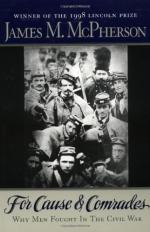|
This section contains 418 words (approx. 2 pages at 400 words per page) |

|
Chapter 12, The Same Holy Cause Summary and Analysis
Civil War soldiers suffered all the same psychological traumas that men of later years would know under the names "shell shock," "battle fatigue," and so on. They saw these traumas as challenges, however. This commitment often produced breakdowns, particularly when coupled with constant marching, little sleep, hunger and extreme temperatures. Combat stress increased most dramatically in the last year of the war and both sides often fell to combat exhaustion.
Post-traumatic stress disorder can also be identified from some war reports and letters. The campaigns of 1864 produced these disorders most clearly. Modern psychologists have shown that a regiment's psychology is completely wrecked by the time it loses one-third of its strength, and this occurred in many cases during the Civil War. By the time 1864 came, many men were simply fighting to stay alive...
(read more from the Chapter 12, The Same Holy Cause Summary)
|
This section contains 418 words (approx. 2 pages at 400 words per page) |

|




